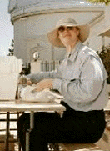|
|
 
|
|
Author
|
Topic: How'd they USED to make subtitles?
|
|
|
|
|
|
|
Stephen Furley
Film God

Posts: 3059
From: Coulsdon, Croydon, England
Registered: May 2002
|
 posted 08-26-2006 03:33 AM
posted 08-26-2006 03:33 AM




Bouncing balls weren't always on film; sometimes they performed 'live'. A Brenograph attachment was available to project a bouncing ball from one lantern, and lantern slides with the words from the other. Come to think about it, you could get attachemnts to do just about anything with a Brenograph. I've only ever seen one once, and it took two operators on the machine to use the thing, one changing the slides and the other bouncing the ball. I'm not sure if it was made by Brenkert, or if it was a third-party product; it doesn't appear in their catalogue.
I suppose you could do it without even having the attachment by using a pinhole slide, and moving the main mirror by hand, but the attachment made it easier. It had a rod with a knob on the end; you twisted the rod to move the ball up and down, and puled it in and out to move from side to side.
| IP: Logged
|
|
|
|
|
|
|
|
|
|
|
|
|
|
|
|
All times are Central (GMT -6:00)
|
|
Powered by Infopop Corporation
UBB.classicTM
6.3.1.2
The Film-Tech Forums are designed for various members related to the cinema industry to express their opinions, viewpoints and testimonials on various products, services and events based upon speculation, personal knowledge and factual information through use, therefore all views represented here allow no liability upon the publishers of this web site and the owners of said views assume no liability for any ill will resulting from these postings. The posts made here are for educational as well as entertainment purposes and as such anyone viewing this portion of the website must accept these views as statements of the author of that opinion
and agrees to release the authors from any and all liability.
|

 Home
Home
 Products
Products
 Store
Store
 Forum
Forum
 Warehouse
Warehouse
 Contact Us
Contact Us




 Printer-friendly view of this topic
Printer-friendly view of this topic








![[Cool]](cool.gif)





![[Smile]](smile.gif) . Something though that I have noticed is that a problem in scope focussing is when the lens is in two parts (standard and anamorphic). When the lens is 1 part full then focussing is no problem!
. Something though that I have noticed is that a problem in scope focussing is when the lens is in two parts (standard and anamorphic). When the lens is 1 part full then focussing is no problem!


